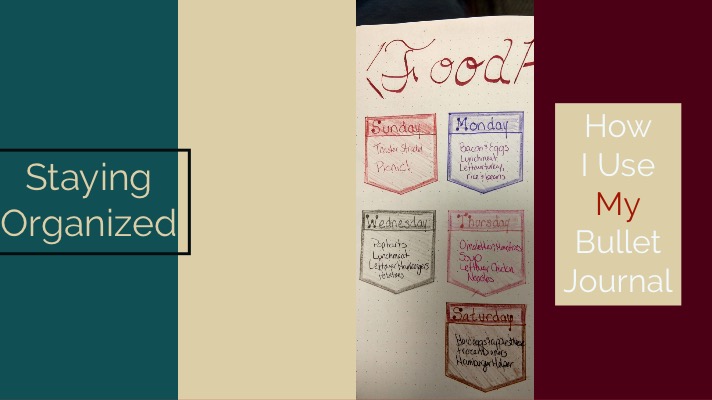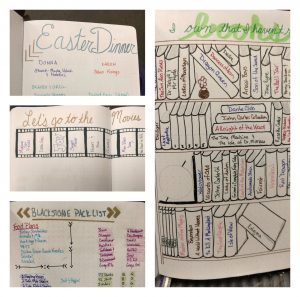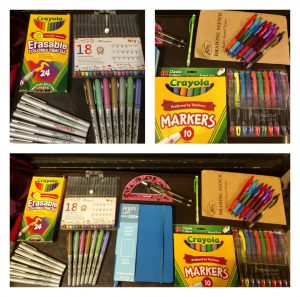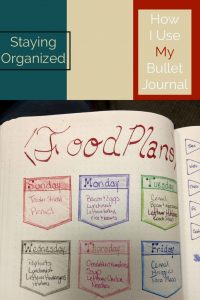Organization: How I use my bullet journal
I have never really kept a journal or a diary. I feel like I’ve tried every type of organization method out there, both paper and electronic. I have had monthly calendars with weekly pages for to do lists, I have had monthly wall calendars, I had a white board that I used as a to-do list and calendar, in college I used to write the due dates of my projects on my closet mirror. Digitally, I have used Google calendar, Planner Plus, Evernote and Google Keep recently. This bullet journal is the only thing that I have been able to stick with. It has worked for every occasion from birthdays to project planning. A bullet journal, put simply, is a way of keeping track of your to-do lists, your calendar, and your diary all in one place. One of the defining characteristics of a bullet journal is the free form it takes. I still use some digital methods for quick notes through the day if I can’t carry my journal. There is just something about putting a pen or pencil to paper that makes me feel as though the plans have become real. My bullet journal gives me a nightly routine. It gives me a sense of accomplishment for the day and a quick picture of what I need to do for the next day.
There are only a few truly defining characteristics of a bullet journal. You do not cross things off when they are done; it is left so you can return later and read what was accomplished or what was moved to another time. Bullet Journals usually have a key to show what projects are completed, what projects are being moved to a different day, and which ones are cancelled. All bullet journals have an index. The index is what makes the journal work. Every page you start, you give it a title, a page number, and enter it into your index before you start writing. Sometimes, it will be a continuation of a thought you started before, so you will add it to a current line in your index. There are three other pages most people have in a bullet journal; a daily log, a monthly log and a future log. I do not currently use a future log in my journal. People I know who keep bullet journals either use blank pages or pages with a series of dots making squares upon the page instead of a lined notebook, but the sky is the limit.
The key allows you to enter and code events quickly when you need to make notes through the day. They call this rapid logging. A bullet is put next to the item if it is something that needs to be done. A circle is put next to it if you need to record something you accomplished. A dash is placed next to a note; if you need to record something that happened that day, or a note to add to a different page later, such as a movie name. Using your key, you can choose to add context to your rapid logs. These are called signifiers. Stars designate important things, or whatever other codes may be important to you, such as a clock for something that is due soon, or an exclamation point for things that inspire you. Feel free to read more straight from the founder at BulletJournal.com.
One of the reasons traditional methods of journaling or organizing do not work for me is because I feel like the whole journal is ruined if I do not write in it every single day, or I do not leave myself enough space for something I would like to write but did not finish. For example, if I leave one extra page to finish writing my pack list for an event, but not everything fits on that page, I would feel like I had to start my list over somewhere else. With a bullet journal, you make up an index. You fill out the index as you add pages to your journal. It gives me an artistic outlet. Your journal can be as simple or complex as you make it. Some of my pages are just rapid logs with no illumination or decoration. Part of what drew me to this type of journal is that I can make it beautiful, and I do not have to have any artistic skill. I can use stencils to make anything
I feel like the bullet journal helps me to work on routines. The Franklin-Covey method teaches you to make space for your big rocks first, and then let the little things fill in the cracks. Let’s say that next Tuesday we need to go grocery shopping, clean the toilets, attend a meeting, write an article and read some of the book I’m currently reading. Right now, I want to do a better job of taking vitamins daily, keeping my fingernails painted, use my new whitening toothpaste twice a day, make a home cooked dinner and post something on social media every day. They would say to put the things you cannot live with out first, such as the meeting and shopping. First I would schedule the things I cannot change.
9:00 AM Leave for shopping
10:00 AM
11:00 AM
12:00 PM Read
1:00 PM
2:00 PM
3:00 PM
4:00 PM
5:00 PM Make Dinner
6:00 PM
7:00 PM Meeting
Then I would fill in the empty space with the other things I want to do.
9:00 AM Use new Toothpaste
Take Vitamin
Leave for shopping
10:00 AM
11:00 AM Put Groceries Away
Clean toilets
12:00 PM Check Nail polish
Read
1:00 PM
2:00 PM
3:00 PM Post Something About my Day
Finish Article
4:00 PM
5:00 PM Make Dinner
6:00 PM Eat Dinner
Use Toothpaste
Leave for meeting
7:00 PM Meeting
Now this is a very generous schedule; I wish this was all I had to accomplish in one day! Since I have some free time, I can fill in some of the free time with some of the little rocks, including all of those new habits I am trying to pick up.
9:00 AM Use new Toothpaste
Take Vitamin
Leave for shopping
10:00 AM
11:00 AM Put Groceries Away
Clean toilets
12:00 PM Check Nail polish
Read
1:00 PM Take Dog for Walk/Run
2:00 PM 1 hr Clean Kitchen – microwave, stove, counters, sink, empty fridge, sweep floor
3:00 PM Post Something About my Day
Finish Article
4:00 PM
5:00 PM Make Dinner
6:00 PM Eat Dinner
Use Toothpaste
Leave for meeting
7:00 PM Meeting
My bullet journal does not break down my day this much; I really do not need it to most days. But if you need a daily timeline every day, the journal gives you the freedom to put it in. You can just put one in when you have a particularly tight schedule coming up. I’m able to use this same method to keep track of professional goals and household chores. I can make up a list of things that needs done yearly or quarterly or monthly and fit in the pieces when they work with the rest of my schedule that week. It means there are fewer last minute projects. I feel like I accomplish a cleaner house because of keeping track.
I do a little bit of extra set-up toward the end of every month. It usually takes me between one hour and two because I draw on the pages. I set up a spread for the next month. I have started to do a splash page for the month, my habit tracker, my cleaning log, and my monthly log. I will go through last month to see what worked and what didn’t. Any tasks from last month I will either move to the current month or strike them from the journal. I have started making weekly logs as well, to help me organize tasks from my monthly log to ensure they get done before the month is over.
What do I need to start? Honestly, all you need is any sort of notebook and a pen. I choose a notebook with a grid dot layout. I am terrible at straight lines, but I don’t suck at playing connect the dots. I recommend a journal, ruler, compass, pencil, colored pencils and felt tip pens. My kit includes an Artist’s Loft dotted paper journal with 249 pages, a 10 pack of Crayola markers, a 24 pack of Crayola colored pencils, a 10 pack of Sharpie highlighters, 18 fineliner felt tip pens by iBayam, a mechanical pencil, an 8 pack of Papermate Profile rollerball pens, a 6 pack of Elegant Writer chisel tip 2.5mm markers, 7 fine point Bic metallic permanent markers, a cork-backed ruler, a compass, Yalis Drawing Stelcils, and a protractor. I pulled some of these sets from other projects I already had, and some of them I purchased because I have trouble controlling myself sometimes. I really use the fineliner pens and the colored pencils more than anything else.
For more ideas for your own bullet journal, here is a list of 50+ pages for your new journal.





